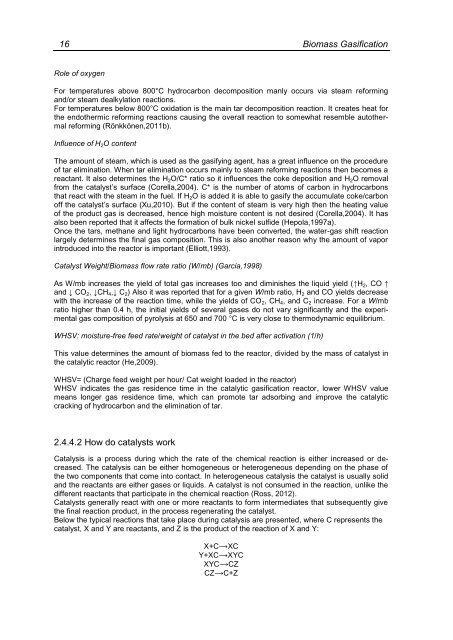Dipl. Ing. Matthias Mayerhofer Technische Universität München ...
Dipl. Ing. Matthias Mayerhofer Technische Universität München ...
Dipl. Ing. Matthias Mayerhofer Technische Universität München ...
You also want an ePaper? Increase the reach of your titles
YUMPU automatically turns print PDFs into web optimized ePapers that Google loves.
16 Biomass Gasification<br />
Role of oxygen<br />
For temperatures above 800°C hydrocarbon decomposition manly occurs via steam reforming<br />
and/or steam dealkylation reactions.<br />
For temperatures below 800°C oxidation is the main tar decomposition reaction. It creates heat for<br />
the endothermic reforming reactions causing the overall reaction to somewhat resemble autothermal<br />
reforming (Rönkkönen,2011b).<br />
Influence of H2O content<br />
The amount of steam, which is used as the gasifying agent, has a great influence on the procedure<br />
of tar elimination. When tar elimination occurs mainly to steam reforming reactions then becomes a<br />
reactant. It also determines the H2O/C* ratio so it influences the coke deposition and H2O removal<br />
from the catalyst’s surface (Corella,2004). C* is the number of atoms of carbon in hydrocarbons<br />
that react with the steam in the fuel. If H2O is added it is able to gasify the accumulate coke/carbon<br />
off the catalyst’s surface (Xu,2010). But if the content of steam is very high then the heating value<br />
of the product gas is decreased, hence high moisture content is not desired (Corella,2004). It has<br />
also been reported that it affects the formation of bulk nickel sulfide (Hepola,1997a).<br />
Once the tars, methane and light hydrocarbons have been converted, the water-gas shift reaction<br />
largely determines the final gas composition. This is also another reason why the amount of vapor<br />
introduced into the reactor is important (Elliott,1993).<br />
Catalyst Weight/Biomass flow rate ratio (W/mb) (Garcia,1998)<br />
As W/mb increases the yield of total gas increases too and diminishes the liquid yield (↑H2, CO ↑<br />
and ↓ CO2, ↓CH4,↓ C2) Also it was reported that for a given W/mb ratio, H2 and CO yields decrease<br />
with the increase of the reaction time, while the yields of CO2, CH4, and C2 increase. For a W/mb<br />
ratio higher than 0.4 h, the initial yields of several gases do not vary significantly and the experimental<br />
gas composition of pyrolysis at 650 and 700 °C is very close to thermodynamic equilibrium.<br />
WHSV: moisture-free feed rate/weight of catalyst in the bed after activation (1/h)<br />
This value determines the amount of biomass fed to the reactor, divided by the mass of catalyst in<br />
the catalytic reactor (He,2009).<br />
WHSV= (Charge feed weight per hour/ Cat weight loaded in the reactor)<br />
WHSV indicates the gas residence time in the catalytic gasification reactor, lower WHSV value<br />
means longer gas residence time, which can promote tar adsorbing and improve the catalytic<br />
cracking of hydrocarbon and the elimination of tar.<br />
2.4.4.2 How do catalysts work<br />
Catalysis is a process during which the rate of the chemical reaction is either increased or decreased.<br />
The catalysis can be either homogeneous or heterogeneous depending on the phase of<br />
the two components that come into contact. In heterogeneous catalysis the catalyst is usually solid<br />
and the reactants are either gases or liquids. A catalyst is not consumed in the reaction, unlike the<br />
different reactants that participate in the chemical reaction (Ross, 2012).<br />
Catalysts generally react with one or more reactants to form intermediates that subsequently give<br />
the final reaction product, in the process regenerating the catalyst.<br />
Below the typical reactions that take place during catalysis are presented, where C represents the<br />
catalyst, X and Y are reactants, and Z is the product of the reaction of X and Y:<br />
X+C⟶XC<br />
Y+XC⟶XYC<br />
XYC⟶CZ<br />
CZ⟶C+Z
















